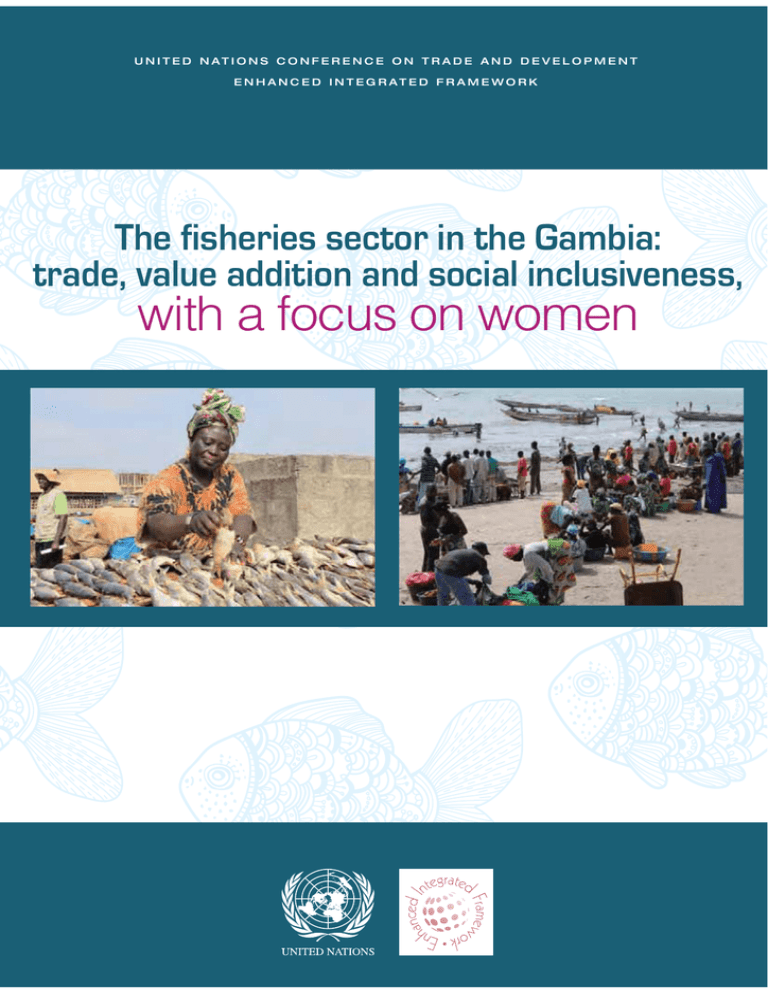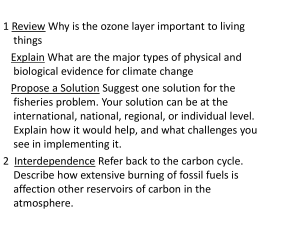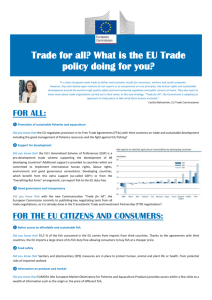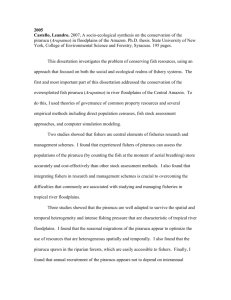
U N I T E D N AT I O N S C O N F E R E N C E O N T R A D E A N D D E V E L O P M E N T
E N H A N C E D I N T E G R AT E D F R A M E W O R K
The fisheries sector in the Gambia:
trade, value addition and social inclusiveness,
with a focus on women
U N I T E D N AT I O N S C O N F E R E N C E O N T R A D E A N D D E V E L O P M E N T
E N H A N C E D I N T E G R AT E D F R A M E W O R K
The fisheries sector in the Gambia:
trade, value addition and social inclusiveness,
with a focus on women
New York and Geneva, 2014
UNITED NATIONS PUBLICATION
UNCTAD/DITC/2013/4
Copyright @ 2014
United Nations
All rights reserved
CONTENTS
ACRONYMS AND ABBREVIATIONS .............................................................................................. v
ACKNOWLEDGEMENTS.................................................................................................................... vi
EXECUTIVE SUMMARY ....................................................................................................................vii
1. INTRODUCTION AND REPORT OUTLINE ............................................................................ 1
2. OVERVIEW OF THE FISHERIES SECTOR ............................................................................. 5
2.1. THE RESOURCE BASE ...................................................................................................................... 6
2.2. THE STRUCTURE OF THE FISHERIES SECTOR ................................................................................ 7
2.2.1. Artisanal Fisheries ................................................................................................................. 7
2.2.2. The Industrial Sector ........................................................................................................... 10
2.3. THE FISH SUPPLY CHAIN ................................................................................................................ 11
2.4. PRODUCTION TRENDS ................................................................................................................... 14
2.5. EXPORT OF FISH AND FISHERY PRODUCTS ................................................................................. 14
2.6. IMPORTANCE OF THE FISHERIES SECTOR TO THE NATIONAL ECONOMY .................................. 15
2.7. KEY ELEMENTS OF THE POLICY ENVIRONMENT .......................................................................... 16
3. CONSTRAINTS AND POTENTIAL, WITH A FOCUS ON WOMEN .............................21
3.1. INDUSTRIAL SUB-SECTOR (FISH PROCESSING) ........................................................................... 22
3.1.1. Potential for Employment Generation and Poverty Alleviation, particularly for Women ..... 22
3.1.2. Constraints Facing the Sector ............................................................................................ 22
3.1.3. Designing a Sustainable, Socially Inclusive and Gender-Sensitive Strategy....................... 27
3.2. AQUACULTURE (COMMERCIAL AND ARTISANAL) ......................................................................... 29
3.2.1. Commercial Shrimp Farming .............................................................................................. 29
3.2.2. Oyster Culture ..................................................................................................................... 30
3.2.3. Rural Fish Pond Culture ...................................................................................................... 31
3.3. THE ARTISANAL SECTOR (HARVESTING AND FISH-PROCESSING) .............................................. 32
3.3.1. Constraints and Opportunities ............................................................................................ 32
3.3.2. Gender-specific Concerns and Corrective Measures ......................................................... 34
4. CONCLUSIONS AND RECOMMENDATIONS ...................................................................37
4.1. ADDRESS STRUCTURAL OBSTACLES AND IMPROVE CAPACITY ................................................. 38
4.2. TACKLE GENDER-SPECIFIC CONSTRAINTS AND ADDRESS SUSTAINABILITY ISSUES ................ 38
4.3. EXPLORE NICHE MARKETS FOR HIGH-VALUE PRODUCTS .......................................................... 40
NOTES AND REFERENCES ............................................................................................................41
ANNEX: METHODOLOGY AND INFORMATION SOURCES ................................................45
iv
THE FISHERIES SECTOR IN THE GAMBIA: TRADE, VALUE ADDITION AND SOCIAL INCLUSIVENESS, WITH A FOCUS ON WOMEN
FIGURES
1. Diagram - Steps in the Fish Supply Chain ................................................................................................ 11
2. Industrial and Artisanal Fish Production (MT), 1997-2010 ......................................................................... 14
3. Exports of Fish and Fishery Products, 1997-2010 .................................................................................... 15
4. Breakdown of Exports (Thousand GMD) of Smoked Fish Products to the Diaspora:
Market by Destination, 2004-2010 ........................................................................................................... 16
TABLES
1. Poverty by Sector of Employment of the Household Head ......................................................................... 3
2. Biomass Estimates of Fisheries Resources ................................................................................................. 6
3. Status of Main Stocks ................................................................................................................................ 7
4. Comparison of the 1997 and 2006 Fishery Frame Surveys......................................................................... 8
5. Industrial and Artisanal Fish Production (MT), 1997-2010 ......................................................................... 14
6. Exports of Fish and Fishery Products, 1997-2010 .................................................................................... 15
7. Export of Smoked Fish Products to the Diaspora Market, by Destination, 2004-2010 .............................. 15
8. Implementation of the Fisheries Act (2007) and Fisheries Regulations (2008) ............................................ 18
9. Estimated Earnings of Industrial Women Processors (GMD) ..................................................................... 22
10. NAWEC Electricity Tariff, July 2012........................................................................................................... 23
11. Matrix of Comparative Data on Landing Fees, Tariff Prices and Incentives (Gambia and Senegal) ............. 24
12. Main Policy Areas ..................................................................................................................................... 39
BOXES
1. Women in the Fisheries Sector ................................................................................................................. 12
2. Addressing Women’s Concerns in Fish Processing Factories ................................................................... 23
3. Tackling Energy Constraints. Renewable Energy ...................................................................................... 24
4. The TRY Oyster Women's Association ..................................................................................................... 32
5. Women as a Target Group for Rural Fish Pond Culture ............................................................................. 32
6. Access to Credit by Artisanal Women....................................................................................................... 34
ACRONYMS AND ABBREVIATIONS
ACRONYMS AND ABBREVIATIONS
ANR
ANRWG
CA
CBG
CBO
CCLME
CCRF
CECAF
CFC
COFI
CRODT
CRR
DOF
ECOWAS
EEZ
EIF
ESMP
EU
FAO
FAO SPWG NWA
FAO/CECAF DWG
FEU
GAFDP
GAFSP
GAMSEM
GAWFA
GBOS
GDP
GMD
GEF
GOTG
GIEPA
GPA
GRT
HACCP
IMR
IMROP
JICA
KWh
MCS
MFI
MOA
NACCUG
NAWEC
NES
NORAD
OMVG
PL
PRCM
SDF
SME
SPS
SRFC
TAGFC
TCP
TOWA
UPDEA
VAT
VISACA
WAQP
WTO
Agriculture and Natural Resources
Agriculture and Natural Resources Working Group
Competent Authority
Central Bank of The Gambia
Community Based Organization
Canary Current Large Marine Ecosystem
Code of Conduct for Responsible Fisheries
FAO Fishery Committee for the Eastern Central Atlantic
Community Fisheries Centre
FAO Committee on Fisheries
Centre de Recherche Oceanographique de Dakar, Thiaroye
Central River Region
Department of Fisheries
Economic Community of West African States
Exclusive Economic Zone
Enhanced Integrated Framework
Environment and Social Management Plan
European Union
Food and Agriculture Organization
FAO Working Group on the Assessment of Small Pelagic fish off Northwest Africa
FAO/CECAF Working Group on the Assessment of Demersal Resources
Fishing Economic Unit
Gambia Artisanal Fisheries Development Project
Global Agriculture and Food Security Program
Gambians in Self-employment
Gambia Women´s Finance Association
Gambia Bureau of Statistics
Gross Domestic Product
Gambian Dalasi
Global Environment Facility
Government of The Gambia
Gambia Investment and Export Promotion Agency
Gambia Ports Authority
Gross Registered Tonnage
Hazard Analysis and Critical Control Point
Institute of Marine Research
Mauritanian Institute of Oceanographic Research and Fisheries
Japanese International Cooperation Agency
Kilowatt Hour
Monitoring Control and Surveillance
Microfinance Institution
Ministry of Agriculture
National Association of Cooperative Credit Union of Gambia
National Water and Electricity Company
National Export Strategy
Norwegian Agency for Development Cooperation
Organization for the Management of The Gambia River Basin
Post Larvae
Regional Coastal and Marine Conservation Program
The Gambia Social Development Fund
Small Medium Enterprise
Sanitary and Phytosanitary
Sub-Regional Fisheries Commission
The Association of Gambian Fishing Companies
Technical Cooperation Program – FAO
TRY Oyster Women's Association
Union of African Electricity Producers, Distributors and Conveyors
Value-Added Tax
Village Savings and Credit Association
West Africa Quality Program
World Trade Organization
v
vi
THE FISHERIES SECTOR IN THE GAMBIA: TRADE, VALUE ADDITION AND SOCIAL INCLUSIVENESS, WITH A FOCUS ON WOMEN
ACKNOWLEDGEMENTS
This analytical report - part of UNCTAD’s activities on trade, gender and development - is intended to accompany the Diagnostic Trade Integration Study (DTIS) Update for The Gambia: Harnessing Trade for Growth and
Employment, carried out under the Enhanced Integrated Framework (EIF) for trade-related assistance for Least
Developed Countries. It sets out a detailed analysis of the fisheries sector and its prospects for value-addition and
social inclusiveness, with a focus on women. The intention is to capture all the information generated through the
DTIS Update process, and disseminate this knowledge to a broader audience.
The preparation of this report involved the pooling of expertise and resources from: UNCTAD’s Division for Africa,
Least Developed Countries and Special Programmes (ALDC); and UNCTAD’s Trade, gender and Development
Section, within the Division on International Trade in Goods and Services, and Commodities (DITC). The study
was prepared by an UNCTAD team led by Simonetta Zarrilli, Chief of the Trade, Gender and Development Section at UNCTAD and Stefano Inama, Chief of UNCTAD’s Technical Cooperation and Enhanced Integrated Framework Section, and including Momodou Cham and Irene Musselli.
The report draws extensively on information and material gathered in The Gambia. The following officials and
experts provided guidance, contributed ideas and gave their time for interviews: Momodou Njie, Principal Fisheries Officer and Head of Inspection Approval and Certification Systems, Inspectorate Unit, Fisheries Department;
Ousman Mass Jobe, Principal Fisheries Officer, Extension Unit, Fisheries Department; Anna Mbenga Cham,
Principal Fisheries Officer, Research and Development Unit (Bio-Statistics), Fisheries Department; Peter Ndow,
Artisanal Fisheries Development Project Coordinator, Fisheries Department; Famara Darboe, Assistant Director,
Fisheries Department; Alagie Sillah, Executive Secretary, and Edrissa Sanyang, Chairman, The Association of
Gambian Fishing Companies; Fern Aguda-Brown, Oyster Women’s Association; Lamin Fofana, Financial Controller, The Gambia Social Development Fund; Patrick Mendy, Finance and Admin Manager, and Nuha Sanneh,
Manager/Projects Coordinator, National Association of Co-operative Credit Unions; Ebrima Ganno, Operations
Manager, Gambia Women’s Finance Association; Aminata Deen, Senior Statistician, Gambia Bureau of Statistics; Alieu Saho, Head of National Accounts, Gambia Bureau of Statistics; Ndene Jallow, Manager, The Atlantic Seafood Company; Lennart Hansson, Manager, West African Aquaculture; Awa Demba, Rosamond Trade,
Gambia; Ida Jobe Lette and Lala Jaiteh, smoked fish product exporters; Yunus Camara and Sheriff Badjie,
Kendaka Fishing; and Fausto Perini, Programme Manager, Economist, Delegation of the European Union to
The Gambia. Their inputs are gratefully acknowledged. Field work in The Gambia was facilitated by Bai Ibrahim
Jobe and Modou Touray, EIF, Ministry of Trade, Industry, Regional Integration and Employment. Their inputs and
logistic support are gratefully acknowledged.
EXECUTIVE SUMMARY
vii
EXECUTIVE SUMMARY
The relationship between trade and gender is highly
contextual and country-specific, as the gender effects
of trade depend on the specificities of individual economic sectors and countries. However, it is at times
possible to extrapolate some general patterns that are
likely to be found across countries. In general terms,
The Gambian case study points to three critical dimensions that should be taken into account when
promoting fish-export-oriented policies as a pro-poor
strategy: i) the existence of gender-specific patterns
in the processing and marketing of fresh and cured
fish products; ii) the resultant, gender-differentiated
impacts of a commercial, export-oriented strategy in
the fisheries sector; and iii) the need for trade policy
responses that are gender-specific and redistributive.
The fisheries sector is a critical entry point for poverty alleviation in The Gambia. It provides a source of
revenue and foreign exchange earnings for the country; but also contributes importantly to food and livelihood security, particularly for the poor. The sector is
the third largest food provider - after agriculture and
livestock - and plays a significant role from a nutritional
standpoint, being the main supplier of animal protein
in the diets of most Gambians. Fisheries and related
activities (processing and marketing) also provide income to the poor: fish-related activities represent the
main source of income for coastal fishing communities, and are an important complement activity (and
safety net) for rural communities inland. In The Gambia, the artisanal subsector employs between 25,000
and 30,000 people, while about 2,000 people work
in the industrial sub-sector. The livelihoods of an estimated 200,000 people are indirectly dependent on
fisheries and related activities. For women in particular,
fish processing and marketing provide an important
source of income and livelihood support: an estimated
80 percent of fish processors and 50 percent of smallscale fish traders are women.
In the sector, men and women tend to produce rather
distinctive products, operate on different scales, and
serve different markets. This results in rather specific
gender-based trade patterns throughout the chain.
Women are the predominant dealers involved in the
domestic marketing of fresh and cured fish products;
while export of the frozen and smoked-dry products
is mainly carried out by men. The operations of the
women fish processors essentially involve small-scale
direct marketing on a daily basis, and low profit margins. Women typically buy a few trays of fresh fish from
large-scale mongers at land sites, and transport it to
various urban markets where the fish is retailed. The
operations of male fish processors and traders tend to
be more capital-intensive and on a larger scale: their
products are marketed to the inland and sub-regional
markets, where the profit margins are higher. Some
large-scale specialist fish dealers (usually men) export
the fish to Senegal - or to Ghana, Guinea Conakry,
Nigeria, etc. - in smoked or dried forms. Processing
factories also procure their fresh fish supply for export
to the EU from large-scale (men) fish suppliers.
This division of labour reflects deeply embedded social roles: in The Gambian context, women look after
the children, work on the family plot, tender small livestock, etc. and are less likely than men to be away
from home. However, it is also a consequence of gender disparities in access to productive assets. Observations at selected landing sites, for example, have
evidenced women’s unequal access to communitymanaged facilities: women tend to occupy units in
need of rehabilitation, for which they pay a rent with
virtually no service provided. As in other contexts, the
overall tendency seems to be that women tend to receive “diminished” assets, while sectors that attract
investment tend to “defeminise”.
The acknowledgement of these gender dimensions is
critical when designing policies geared towards upgrading the fisheries sector in The Gambia. The rationale for gender-sensitive measures in this context
is twofold.
First, if the constraints affecting women’s ability to carry
out their trade are not addressed, this may negatively
affect the overall prospects for sector development,
as women represent the majority of fish processors
and about half of fish traders. Improving the overall efficiency of operations will largely depend on ensuring
that women processors and traders - as well as men
- have sufficient access to quality supplies, upgraded
facilities, and credit and support services.
Second, given women’s crucial roles in the domestic
marketing chain, any efforts to reduce food insecurity must take into consideration the constraints that
women face in their trade. It is important to note, in
this respect, that an expansion of the export-oriented
viii
THE FISHERIES SECTOR IN THE GAMBIA: TRADE, VALUE ADDITION AND SOCIAL INCLUSIVENESS, WITH A FOCUS ON WOMEN
fish-processing industry is likely to generate significant employment opportunities for relatively unskilled
women downstream (factory processing), with positive effects in terms of poverty alleviation. However,
it may also unleash dynamics of social polarization
and exclusion upstream in the chain, with potentially
important food security implications. This is because
the expansion of an export-oriented fish industry may,
to some extent, accentuate the dual-nature structure
of the fisheries chain. In particular, it may incite some
diversion of resources from the domestic segment
(domestic marketing and distribution of fresh fish and
traditionally processed products) to the export-oriented segment (particularly fresh and frozen fish products
serving the EU market). This could act to the detriment
of small-scale women operators, who mainly operate
in the domestic segment. More generally, the selective upgrading and segregation of the export-oriented
segment of the chain may accentuate social cleavages between the relatively empowered and the relatively disempowered; and between large-scale dealers (involved in the export segment) and small-scale
traders (predominant in local marketing). Also, for
those fish species that serve both the export and domestic markets, there may be some diversion of supplies from the domestic to the export chain, with important food security implications. To effectively tackle
food security issues it is thus important to identify and
understand the dimensions and relevance of gender
issues and gender-based constraints, and take corrective actions.
Hence, a call for trade policy responses that are not
only gender-specific (in that they respond to practical
gender needs of either sex), but also gender-redistributive (as they tend to create a more balanced relationship between men and women in access to productive resources). Three important intervention areas are
outlined below.
A critical issue is the integration of gender considerations into the design and implementation of fisheries
infrastructure projects. It is important, in particular, to
acknowledge and address gender-based constraints
throughout the planning, implementation and monitoring of projects aimed at the rehabilitation and expansion of facilities at fisheries landing sites and fish
domestic markets. The objective is to ensure that facilities used by women are upgraded, or that upgraded
facilities (including those that serve the export-oriented segment of the chain) can be effectively accessed
by women, as well as men. Concrete measures may
include quotas, informal complaints procedure, etc.
Community mobilization in the identification and enforcement of suitable gender-redistributive measures
is critical in this context, as the whole process should
be endogenous, from within the community. Community leaders, in particular, should be mobilized to
support women’s access to resources. Prioritized investment should also continue to include facilities that
cater to small-scale operators (women) who serve the
domestic market, and not only facilities designated for
export. Strategic domestic-oriented facilities would include: ice plant and cold storage facilities to market
high quality fish products at main urban/inland markets; fish handling and processing equipment and improved processing techniques in the domestic chain;
packaging material at landing sites; and dedicated,
well-equipped fish markets.
Parallel action should be taken to favour women’s access to resources (credit) and support services (training and extension, and marketing). As regards access
to credit, affirmative actions taken to redress power
imbalances may include a target percentage of credit to be disbursed to women and dedicated lines of
credit for women operators. Training is needed in at
least three key areas: i) technical training in the handling, processing, and marketing of fish and fish products (fresh and cured) with a view to improving food
security and quality; ii) marketing (how to use market
information and establish business contracts and alliances); and iii) record-keeping and business plan
formulation (this will help micro-finance institutions to
assess credit-worthiness).
It is also important to explore niche markets for highvalue products that can generate income for women.
The potential for commercial and artisanal aquaculture involving shrimps and oysters is high. Shrimps
offer significant potential for a product differentiation
strategy (antibiotic-free shrimp with unique characteristics in terms of texture and size), with a focus on
high-value niche markets (e.g. gourmet restaurants
in Europe). Artisanal oyster farming, involving women
oyster harvesters, can expand the local oyster trade
and even encourage the development of the half-shell
trade to supply The Gambian tourist market. A different niche of interest for potential development and expansion is that of traditional ethnic foods of value for
The Gambian Diaspora. Specifically, there is a potentially important niche export market for smoked catfish
and other high-value fish species including shrimps,
barracuda, etc., to The Gambian Diaspora in Europe
EXECUTIVE SUMMARY
and America. The realization of women’s commercial
potential in these areas depends on enhancing their
access to credit and support services (training, extension and marketing). The strict implementation of
stringent sanitary and phytosanitary measures is also
critical, particularly if the focus is on high-value niche
markets. Equally important is the siting of operations,
ix
which must be chosen taking into due account potential environmental pollution. Finally, in order to effectively identify and tackle market access and market
entry barriers, it is key to set up strategic alliances involving women operators, key public entities, and offtakers (for example: traders, specialized wholesalers
and retailers in targeted export markets).








